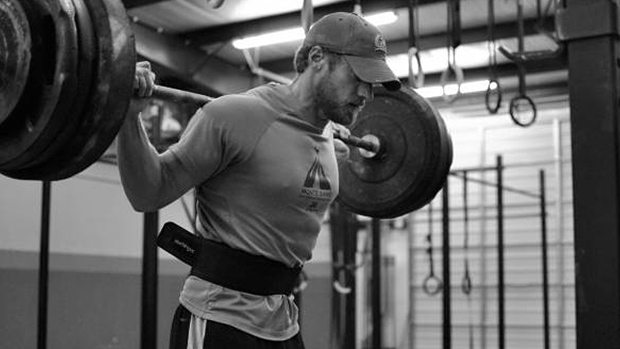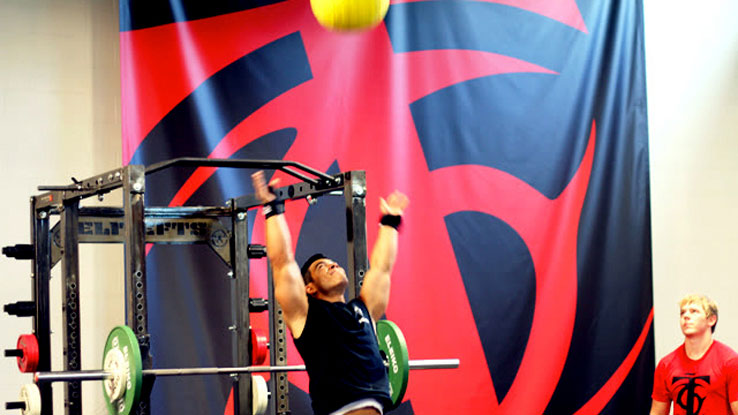Some lifters need more mobility work in their warm-up to prevent an injury from occurring. Others can get away with a faster warm-up if their mobility is adequate. Which type of lifter are you?
The quickest way to tell is by performing an overhead squat with a PVC pipe or dowel.
- Stand barefoot with your feet at shoulder-width with your toes pointed straight forward. Although you probably don't squat with your toes pointed straight forward, this allows you to better analyze your ankle mobility.
- Place the PVC pipe on top of your head with your elbows bent to 90 degrees.
- Press the PVC pipe over your head so your arms are straight.
- Squat down as deeply as you can. Pause at the bottom for about one second.
Can you squat below parallel with a vertical torso, lower back in a neutral position, heels grounded, knees tracking out, and keeping the PVC pipe over your mid foot? Then you're in good shape from a mobility perspective. If not, keep reading.
This lift requires significant mobility through the extremities as well as stability through the core. The entire body has to move in coordination with excellent control. It's an effective tool to screen for immobility in certain areas that can give you problems down the road.
For example, let's take a look at how an immobile thoracic spine could cause elbow pain during your back squat (1). Below are two photos of me getting ready to back squat. The first photo is more typical of someone who has an immobile T-spine (generally characterized by tight pecs and lats).

As you can see, I can't get my palm to wrap around the bar, which means the bar has to roll towards my fingers. This puts my wrist into a considerable amount of extension, leading to medial elbow pain due to the excess stress placed upon the forearm flexors.

This second photo shows a more mobile T-spine. Here I'm able to grasp the bar firmly. This position keeps my wrist more neutral, which will help prevent elbow pain.
Now Let's Get You Fixed
If you struggled with the test, you probably have tight ankles, lats, pecs, or all the above.
Tight ankles will throw you off balance as you start to get near parallel. In an effort to maintain balance, you'll most likely either lift your heels off the ground or round your lower back (butt wink) to complete the full squat.
A good plan of attack would be to foam roll your calves, do a banded ankle mobilization, and do some eccentric heel drops as part of your squat warm-up.
Banded Ankle Mobilization

Place the band across the talus bone in your ankle so that the force of the band is directed down and back. Keep your entire foot grounded as you push your knee forward and over your toes.
Elevated Eccentric Heel Drops
Use an elevated surface so that your heel has to drop below the front part of your foot. Take about 3 seconds on the way down and pause for 1-3 seconds at the bottom to stretch the gastroc and soleus muscles in your calves.
If you have an immobile T-spine you'll see your upper body move forward to compensate for squat depth. If this is you, a good strategy would involve some soft tissue work on your pecs/lats, followed by a few mobilization drills for the T-spine, like the cat/cow and the thoracic spine reach-through.
Cat/Cow
- Begin on all fours with your palms stacked underneath your shoulders.
- As you inhale, lift your head, squeeze your shoulder blades together, and put a slight arch in your lower back.
- As you exhale, tuck your chin to your chest, round your upper back, and think of tucking your tailbone underneath you.
- Perform 5-10 passes, pausing at the top and bottom of each breath for 1-3 seconds.
Thoracic Spine Reach Through
- Begin on all fours with your palms stacked underneath your shoulders.
- Reach one arm up towards the ceiling and back behind the body to stretch the pecs. Externally rotate your shoulder by using a "thumbs up" position as you do this. This will keep your shoulder in better alignment for the reach.
- Reach your arm underneath your body. Try to get your head and ear toward the ground to get a stretch through your upper back.
- Horschig, A., & Sonthana, K. (2021). Rebuilding milo: The lifter's guide to fixing common injuries and building a strong foundation for enhancing performance, pp. 328-329. Las Vegas: Victory Belt Publishing.



